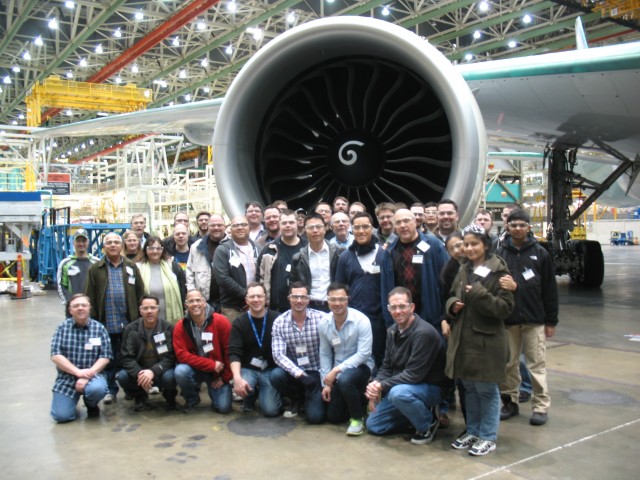
One of three Aviation Geek Fest groups that toured the Boeing Factory Floor. Photo by Boeing.
This weekend was amazing. Almost 200 people attended Aviation Geek Fest 2013 in Seattle this year — it was bigger and better than ever.
Many attendees came from the Seattle area, but we are quite a few who came from out of state: Colorado, Oregon, Minnesota, Arizona, Georgia, Florida, New York, Texas, North Carolina, Nevada, Montana, Hawaii, Massachusetts and California.
The group was also international. There were a few folks from Canada (British Columbia, Ontario and Quebec) and a father and son came all the way from Oslo Norway for the event. This has truly turned into a world event and it makes sense since Seattle is a major hub for aviation lovers. Awesome.

The point of the event is to bring aviation lovers (or AvGeeks) together to celebrate our passion and do some pretty cool things together.
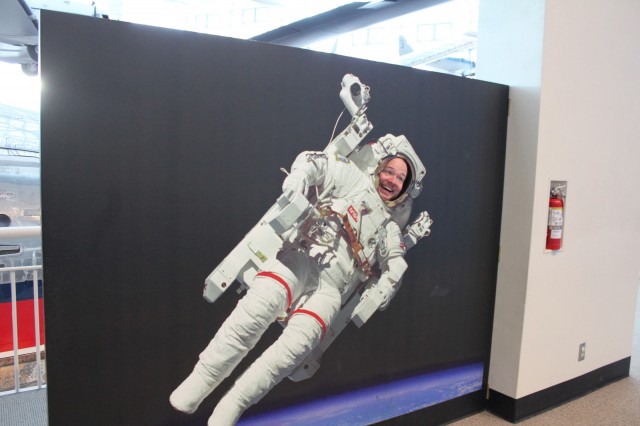
We all got to check out the new space exhibits, including the Space Shuttle trainer at the Museum of Flight. Image by AirlineReporter.com.
This was the first year where the event was two days. Saturday, the 16th, took place down south at Boeing Field and Sunday took place up north at Paine Field. Starting at 9am, AvGeeks were able to enter the Museum of Flight and start their aviation adventure.
Our group had own room up on the top floor, overlooking the runway with free coffee, tea and water — all of which was needed to keep up during the day. The 737 tour was not until, noon, which gave people plenty of time to check out the Museum of Flight.
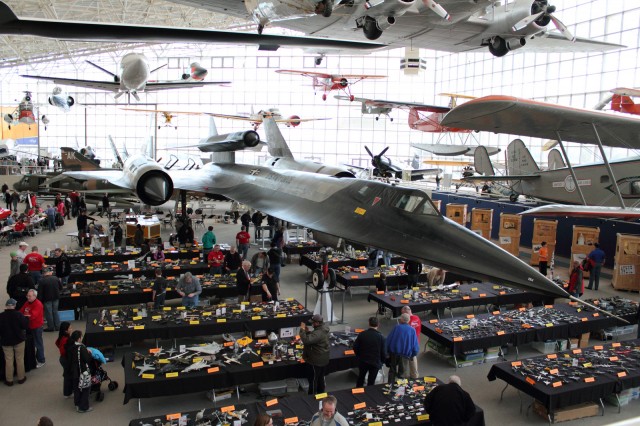
There was a model show going on at the Museum of Flight. Image by AirlineReporter.com.
I spent the morning up at #AGF13 HQ (the room at the Museum of Flight) talking aviation and airlines with all the AvGeeks that showed up. At about noon, it was time for us to prepare to get on the three buses to be taken to the Renton 737 Factory. The only down side to the tour is we were not allowed to take any of our own photos. Luckily, Boeing agreed to take some photos for us and share them.
On the ride over to the 737 factory, I Tweeted out a photo of the AvGeeks on my bus and was told they looked sad. This was because I just got done telling them, “no phones and no cameras,” then took the photo. Right after, I also explained that everyone was getting a free $20 gift card to The Boeing Store — that is when I should have taken the photo — oops.
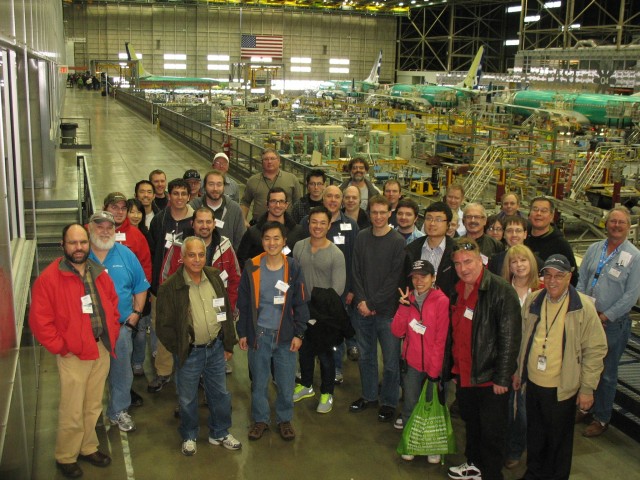
One of the AGF13 groups inside the Renton 737 Factory. Photo by Boeing.
Our 737 tour started with a few short videos highlighting the 737 and of course the new MAX. This tour was super VIP, since it is not open to the public and they stated that this was the largest group that have toured the facility. We were broken into four groups and taken down both of the 737 lines. Since it was Saturday, the line was not moving, but we all enjoyed figuring out the airlines that the 737s belonged to by the liveries on their rudders and winglets. Not too surprising, there was not one livery that could stump our group.
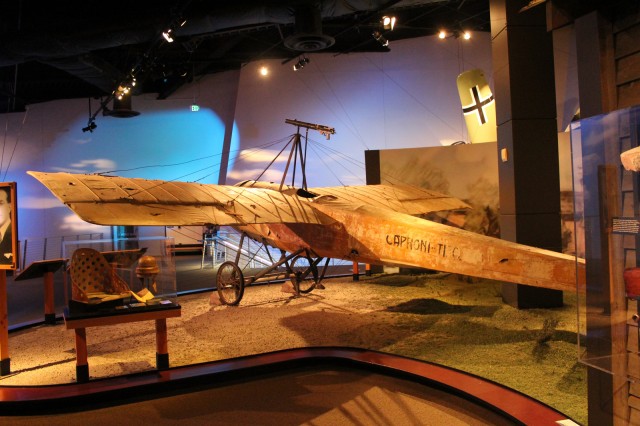
The world’s first fighter plane: the Caproni Ca.20 at the Museum of Flight. Image by AirlineReporter.com.
After the tour, it was back on the buses and we headed back to the Museum of Flight. I hadn’t been in a few years, so I took about two hours quickly going through their new shuttle trainer and checking out old friends (Concorde, first Boeing 747, Constellation, among others) in the Air Park. The museum closed at 5pm, but we were given a special after hours tour of the Personal Courage Wing, which shows off aircraft and memorabilia from World War I and II.
By the time our tour was done at 6:30pm I was quite tired. Really we only had one scheduled event: the 737 tour, but everyone was kept busy the entire day. It was a great day, but I was excited for the next.
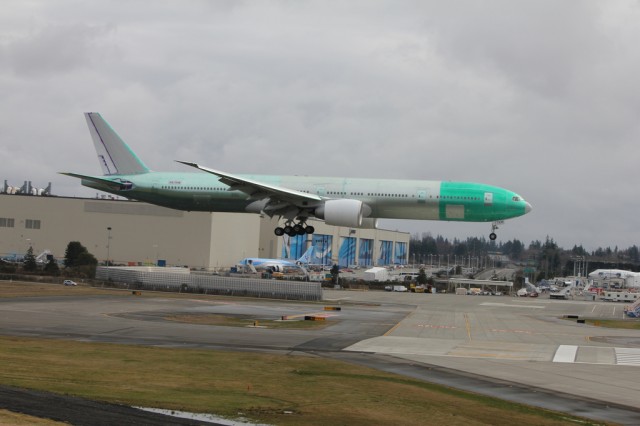
Upon arriving at the Future of Flight, we were greeted by a few Boeing 777’s viewed from the Strato Deck. Image by AirlineReporter.com.
I was up earlier than I normally am during the weekend, but I didn’t even need coffee right away, I had AvGeek adrenaline in my blood. Shortly after arriving at the Future of Flight, we were treated with a few Boeing 777 test flights, viewed from the strato deck. Like down south, we had our own AGF13 room with coffee to fuel us through the day.
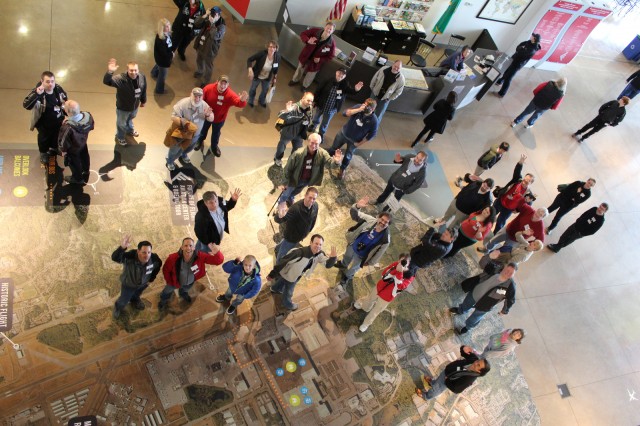
Getting ready to head to the Dreamliner Gallery, AvGeeks hang out at the Future of Flight. Image from AirlineReporter.com
Throughout the day, AvGeeks had the ability to check out the Future of Flight, Historic Flight Foundation and the Flying Heritage Collection free of charge. Although I wasn’t able to do everything, it was fun watching the #AGF13 hashtag on Twitter to see what everyone else was up to. I was hoping to get over to also see the Flying Heritage Collection and the Museum of Flight Restoration Center, but I just ran out of time — next year I promise.
Our Boeing Factory floor tour was set at 3pm. Before hand, at 10am, 11:30am and finally at 1pm, there were separate tours to the Dreamliner Gallery.
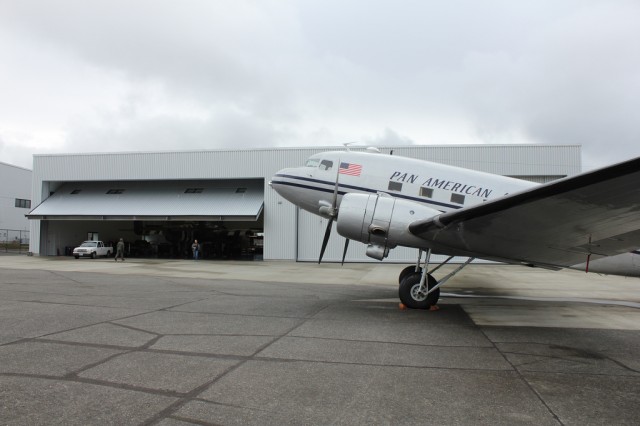
Restored Pan Am DC-3 at Historic Flight. Image by AirlineReporter.com.
My tour wasn’t until 1pm, but I was once again enjoying talking with the other AvGeeks who were hanging out at the Future of Flight. At about noon a group of us saw via social media that the DC-3 at Historic Flight Foundation was open and very quickly, we were all piled into a car and headed over. I don’t think I have seen a group of AvGeeks move so fast.
I have seen the outside of the plane before, but never the inside — she is a beauty. Historic Flight is hoping to offer rides to paying passengers later in the year (hopefully more on that in a future story).
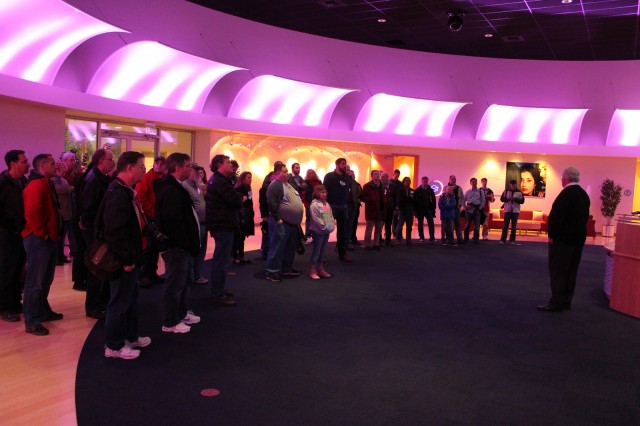
Our group got to check out the Dreamliner Gallery. Image by AirlineReporter.com.
After grabbing a quick lunch, we hurried back to the Future of Flight to catch our bus to the Dreamliner Gallery. The gallery is the place where airlines go to design the interiors of their 787’s. This is the first facility like this in the world that allows customers to figure out so many options at one place, greatly reducing the time and money spent to prepare a new aircraft to join their fleet.
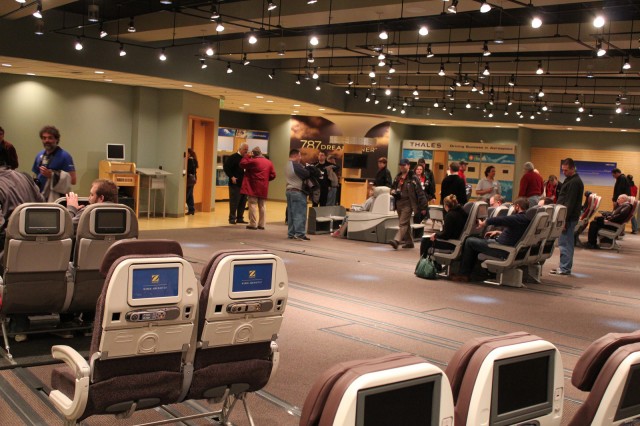
Checking out the different seating options of the Dreamliner. Image by AirlineReporter.com.
Like the 737 factory, the Dreamliner Gallery is not normally open to the public. We went room-to-room looking at seats, lighting, galley options, lavatories and even crew rest areas. None of us wanted to leave, but we were excited to take our Boeing Factory floor tour. We boarded our bus again and headed back to the Future of Flight for a short video before getting on another set of buses to be taken to the factory.
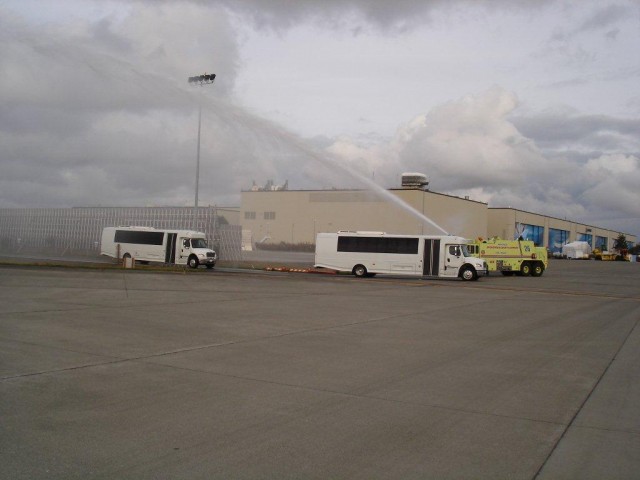
Three of the buses got a water canon salute. Photo by Snohomish County Airport Fire Dept.
It is a nice tradition that aircraft get a water canon salute — our buses were no different — at least most of our buses. We were split up into four different buses and just so happens that two of the buses (one which I was on) missed the water canon salute. The other two received a nice wash down from the Snohomish County Airport Fire Department. Kindly, one of the fire fighters took photos and shared them with us.

AvGeeks in front of a Boeing 747-8I on the factory floor in Everett. Photo by Boeing.
Our four AvGeek groups toured around the factory floor, including the new 787 surge line. I have toured the factory a number of times now, but each time is a bit different and it never gets old walking among the brand new airliners. Being on the floor is very different than the public tour that takes place up on the walking platforms. I much more enjoy looking up at a 777, 787 or 747-8 than looking down.
After our tour, it was back on the buses and to the Future of Flight for an AvGeek social with pizza and beer.
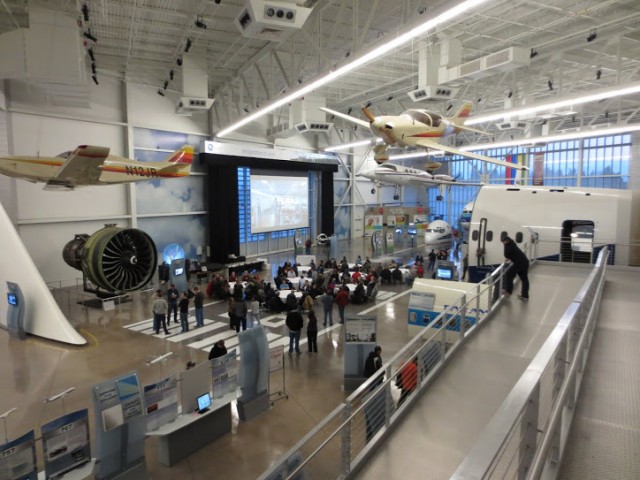
The Future of Flight gallery floor set up in AvGeek social-mode. Image by Mal Muir.
Part of the social was giving out a number of prizes, including two free tickets on Southwest Airlines. By the time I was heading home, I was exhausted — but in a good way. There was quite a bit of walking, talking and learning and I was so thankful everything went so smoothly.

Will there be an Aviation Geek Fest 2014? Heck yes there will! Start preparing now.
We are going to set the date to be President’s Day Weekend for next year, which is February 15th and 16th, 2014. The event will likely be similar with new and exciting things. Be sure to add your email to the AGF e-mail list (if you already signed up for AGF13, you do NOT need to sign up again). No details yet, but we are planning for it to be epic.
A huge thanks to…. the Future of Flight, Boeing, Museum of Flight, Historic Flight Foundation, the Flying Heritage Collection, Southwest Airlines and everyone else who helped to make this an amazing event. I cannot wait until next year!
125 PHOTOS OF AVIATION GEEK FEST
More AGF13 Goodies:
 |
This story written by…David Parker Brown, Editor & Founder. David started AirlineReporter.com in the summer of 2008, but has had a passion for aviation since he was a kid. Born and raised in the Seattle area (where he is currently based) has surely had an influence and he couldn’t imagine living anywhere else in the world.@AirlineReporter | Flickr | YouTube |

Photo of Paine Field taken just a few days ago. Many Boeing planes might have been delivered in 2012, but there are still many parked at KPAE. BTW, looking at this photo you have brand new Boeing planes and Mount Rainier in the background. I love living in Seattle.
Boeing had a pretty darn good 2012. They received 1,203 net commercial orders and had 601 deliveries. One of the best successes for Boeing was the 737 and the new more efficient MAX model (still not keen on that name).
Of the 1,203 net orders in 2012, 1,124 of those were for the 737 and 914 of those were for the MAX. Not to mention that the 737 celebrated its 10,000th order earlier in 2012.

Boeing orders and deliveries for 2012. Chart from Boeing.
Boeing President & CEO Ray Conner sent a letter to all Boeing Commercial Airplanes employees to recognize their ’˜incredible’ contributions to the company’s success in 2012. I figured it was something worth sharing:
As we kick off a new year, I’d like to recognize your incredible accomplishments in 2012. You’ve demonstrated through your hard work and dedication that you are the best aerospace team in the world.
Thanks to your efforts, we ended the year with 1,203 net orders ’“ the second-largest total in company history. We delivered 601 airplanes ’“ the most since 1999 ’“ and we continued to raise the bar across all programs. We also advanced our services strategy and increased the breadth of our offerings to customers.
On the 737 program, we booked 1,124 net orders ’“ unprecedented for any of our models in a single year ’“ and celebrated the program’s 10,000th order. The Next-Generation 737 set a record for deliveries ’“ 415 in the span of a year. And the 737 MAX logged 914 net orders, pushing us past the 1,000 order mark.
Our strong performance extended to the twin-aisle programs as well. The 787 program closed out the year with 46 deliveries ’“ including 11 Dreamliners in December alone. In all, we have delivered 49 787s to eight customers. The 777 program made a milestone 1,000th delivery, the 747-8 Intercontinental and Freighter continued to receive positive reviews for performance from customers, and the 767 team helped the KC-46 Tanker program meet or surpass its development milestones for the year.
Not only that, in December we delivered 15 airplanes in a 24-hour period from Everett, Renton and Charleston combined ’“ the most in one day since 1998 ’“ highlighting our collective strength as one team. We achieved all this while stepping up production 26 percent over the course of several rate increases throughout the year. This is outstanding work by an amazing team and I know our customers appreciate it.
Looking forward, our customers continue to face an increasingly tough business environment, making it more important than ever that they acquire more-efficient products and services at lower costs. To help meet demand, we’ll continue to focus on raising production rates and continuously improve how we build airplanes. We’ll transition the 787-9 into production and flight test and continue working toward the 787-10X and the 777X, guided by the needs of our customers.
On our development programs, we will be more disciplined as we implement lessons learned from the past. We’ll think early in the process about how we can better support our customers throughout the product lifecycle, while ensuring our own profitability.
With a backlog of 4,373 unfilled orders ’“ the highest in our history ’“ we have huge opportunity ahead of us if we execute on our commitments. We know we have the right products and we’ve proven we know how to increase rates. I know we have the right team to make it possible.
It takes our entire team to be successful ’“ everyone is an important player. That means we need to look out for one another and be relentless about achieving our goal for a safe work environment with zero injuries. It also means having a culture where we treat our teammates with the highest level of integrity and respect. As we all sign Boeing’s Code of Conduct this month, we should think about the kind of culture we want to have ’“ one that makes us proud to work here. Let’s make it happen.
Once again, I’d like to thank you for making last year so successful. I look forward to the year ahead.
Ray
 |
This story written by…David Parker Brown, Editor & Founder.
David started AirlineReporter.com in the summer of 2008, but has had a passion for aviation since he was a kid. Born and raised in the Seattle area (where he is currently based) has surely had an influence and he couldn’t imagine living anywhere else in the world.
@AirlineReporter | Flickr | YouTube |
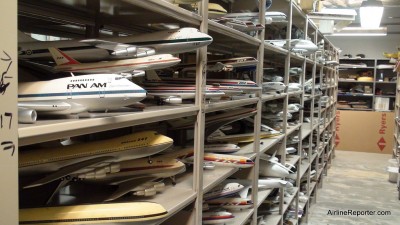
How would you like to have this airline model collection located in the Boeing Archive? Um, yes please.
A while back I had the amazing experience of checking out Boeing’s archive located in Bellevue, WA. My first post in September gave the general overall look at the archives. Unfortunately since then, I got distracted with other things and caused a delay. This post will be going over the models (airplane not people) found in the archives and next week I will be posting my interview with Boeing Historian Michael Lombardi.
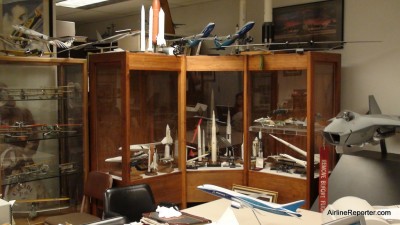
These are just some of the models located in the lobby of the Boeing Archive. They keep the real good ones locked up.
When I went for my visit in September, I was expecting the archives to be a bunch of boxes on shelves. One of the best surprises were all the amazing and unique models housed in the archives. From single aisle Boeing 747 mock ups to Boeing boats, I felt like a kid in a candy store needing a sugar rush. The archive has so many models, it has been difficult to store them all. I told Lombardi that I would be more than happy to store some at my house, but I don’t think that will work out. Although some models were spread around in the lobby and on random shelves, most were stored in two long rows of shelving. There were military and commercial airline models, but of course my main interest were the airliners.
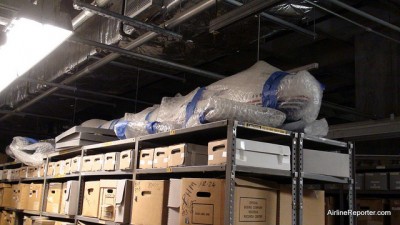
I got so distracted by learning about the Boeing boats, I forgot to take a photos. But I did catch this HUGE Boeing 747 model.
Did you catch I said “Boeing boats” earlier? I am not talking about the Boeing 314 Flying Clipper, I am talking about real boats. Using their knowledge from aerodynamics, Boeing dove into the world of hydrofoil/jetfoil boats. They first launched in 1962 and built boats for military and commercial use until 1988 when Boeing Marine Systems closed and sold the license for the Commercial Jetfoils to Kawasaki Heavy Ind. Lombardi tells me that some Boeing Jetfoils are still “flying” to Macao and between Korea/Japan.
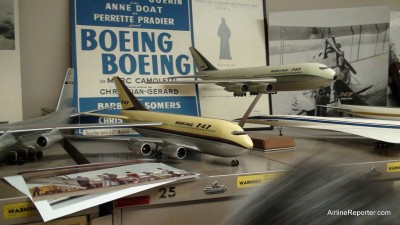
Two single aisle, double deck mock ups for the original Boeing 747.
When Boeing was looking at making a larger aircraft after the Boeing 707, they played with the idea of a double-decker, singled-aisle airplane like these two models depicted above. Can you spot the differences (larger version)? One has the wings in the middle of the fuselage, the other a bit higher. Also check out the differences in landing gears. These models look much more like the Airbus A380 than they do the Boeing 747. You can really see the nose of the Boeing 707/727/737 in the white model. Also, do not miss the Boeing SST model, there were quite a few of those spread out around the archive.
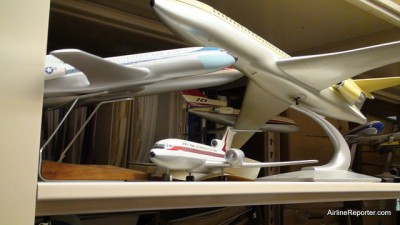
This is one odd-looking potential Boeing 727
This little guy (seen above) was hard to spot amongst all the models, but looked very interesting. Lombardi explained what the function of the engines being placed on the wings. “During the 1970s Boeing studied all aspects of commercial aviation and also reviewed the entire commercial family to see what could be improved. This model of the 727 shows one of those considerations it is a STOL 727 using a concept called USB or upper surface blowing. USB was successfully tested on the Boeing QSRA and the Boeing YC-14.” The Boeing 727 is one of my favorite airliners since it looks so majestic. I don’t think I would have the same love if it looked like the model above or like this other funky looking 727 model.
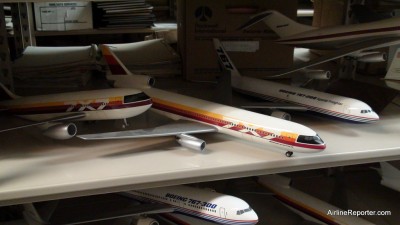
These show what Boeing was looking at with the Boeing 767.
There was a pretty big section of Boeing 767 prototype models in the Boeing archive. There were ones that closely resemble what became the Boeing 767 and others that looked… well, unique. Boeing was playing with the idea of making the 767 being a quad or even tri-jet aircraft. Probably the most interesting Boeing 767 prototype is the one you can see on the right on the photo above and detailed in the photo below.
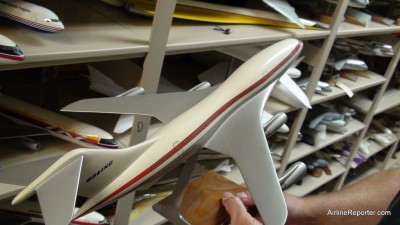
Check out the sweet waistline on this possible Boeing 767 design.
This was one of my favorite models. That slick waist-line shape would have allowed the plane to travel at near sonic speeds. Lombardi explained why it wasn’t chosen. “Much like the Sonic Cruiser and it did not go forward for the same reasons that the Sonic Cruiser did not go forward – the fuel burn increases dramatically at near sonic/transonic speeds because of the increased drag.” I would imagine the seat layout on the interior would have been interesting and a bit cumbersome.
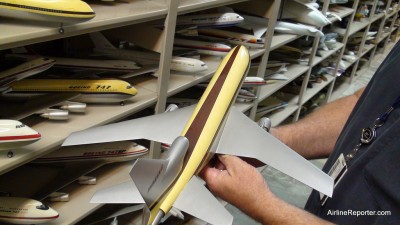
A model of the Boeing 747 Tri-Jet at the archive.
No matter how many times I have seen the mock ups, the Boeing 747 TriJet always looks odd to me. During the 1970’²s Boeing wanted to better compete with the DC-10 and L1011. The Boeing 747SP was too costly to directly compete, so for a short while, Boeing looked at creating a 747 with three jets instead of the standard four. The design has two jets on the wing and one on the tail in an ’œS’ configuration, much like the L1011. The concept was scrapped since it would take too much time, money, and a new wing design.
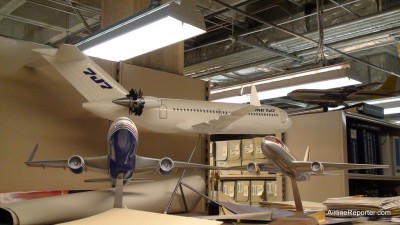
Ah, the Boeing 7J7. Wait a second... is that a Boeing 767 with foldable wings?
The Boeing archive wouldn’t be complete without a model of the Boeing 7J7. This aircraft was designed in the 1980’s with the idea of replacing the Boeing 727. It used Unducted Fan Engines on the rear of the plane that provided superior fuel economy. Boeing hoped the 7J7 would burn about half the fuel of the Airbus A320 and hoped to revolutionize commercial air travel. A reduction in oil prices and noise concerns ended up killing off the 7J7. Might we see another version of the UFE in the future? I am going to bet on yes.
Be sure to take a look at all 44 photos taken of the Boeing archive.
Inside The Boeing Company Archives
PART 1 | PART 2 | PART 3a | PART 3b | ALL PHOTOS | ALL STORIES
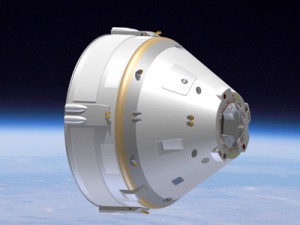
Boeing's mock up of what the CST-100 will most likely look like. Photo from Boeing.
The Boeing Company has been making things that go into space for quite some time now. Earlier in the week, they announced plans to possibly start sending normal Joe-Schmos into space…for a price.
Boeing and Space Adventures have created a memorandum of agreement regarding the marketing the transportation of passengers on commercial flight board the Boeing Crew Space Transportation-100 (or CST-100) to low Earth orbit.
Boeing plans to use the CST-100 to transport crews to the International Space Station, but will also provide room for private individuals, companies and pretty much anyone who isn’t NASA to hitch a ride.
Boeing and Space Adventures have not yet set a price per seat for spaceflight participants, but will do so when full-scale development is under way. Boeing continues to advance its design for the CST-100 spacecraft under NASA’s Commercial Crew Development Space Act Agreement. The spacecraft, which can carry seven people, will be able to fly on multiple launch vehicles and is expected to be operational by 2015.
“We are excited about the potential to offer flights on Boeing’s spacecraft,” said Eric Anderson, co-founder and chairman of Space Adventures. “With our customer experience and Boeing’s heritage in human spaceflight, our goal is not only to benefit the individuals who fly to space, but also to help make the resources of space available to the commercial sector by bringing the value from space back to Earth.”
At this point there is no cost set up for these flights, but don’t expect them to be cheap.
In my opinion this is awesome. Virgin Galactic is already well on their way to start space tourism and getting a big company like Boeing involved will just up the stakes and create competition.
View cutaway image
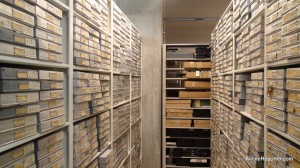
Inside the Boeing Archive. These are all films from Boeing's past. How awesome would it be to watch them all?
Boeing is one huge company. Currently, they have about 160,000 employees that do things from building planes to cleaning windows. The Boeing Company was first established in 1916 and has such an amazingly interesting history. What does a company like Boeing do to keep their history intact and make sure great ideas don’t fall between the cracks? I didn’t know, but I wanted to find out.
Recently I was fortunate enough to be invited to take a tour of the Boeing Archive and sit down with Boeing Historian Mike Lombardi. Since there was so much information to see and learn, I will present what I discovered in the archives in a three part series. In this first part, I will talk about the archives. Then in part two, I will share with you all the incredibly preserved Boeing models they have there. Finally, I will share my interview with Lombardi.
Even though most people associate Everett (Paine Field) and Renton (where 737’²s are made) with Boeing in the Seattle area, the archives are housed in a Boeing complex in Bellevue, WA, which is located just east of Seattle. The archive in Bellevue is the main corporate archive and preserves the history of Boeing and the aviation history of North American/Rockwell. The archives are for current commercial business as well as Boeing corporate.
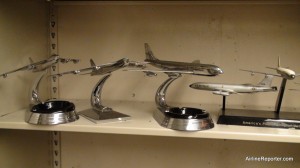
In the Vault: these classic Boeing ashtrays, which were very popular with Boeing engineers back in the day.
Over the years, the archive has grown to include other locations across the nation. There are the Douglas archives in Cypress, CA (near Long Beach), where the history of Douglas is preserved as well. It also houses Boeing’s current space and electronics related businesses that are in southern California. Boeing’s archive in St Louis takes care of the history of McDonnell Douglas and Hughes helicopters and supports their current military aircraft and defense business.
I was quite fascinated with the multiple levels of security attached to the Bellevue archive. First, guests must check-in at a public building to get their ’œEscort Required’ badge. Then, it is through a security gate where guests have to show said badge with their escort (who, for me, was the very helpful Bernard Choi with Boeing Communications). After the second security check, there are various doors one must go through that require a code before they reach the basement archives.
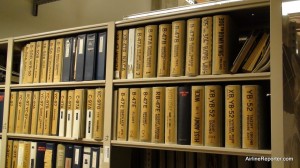
How cool would it be to have a few weeks to sit down and read all these?
Most of Boeing’s history is housed in an earthquake resistant basement, where computer chips used to be made. There are long rows of boxes with models (which I will talk about in Part 2), posters, films and trinkets almost everywhere. I was surprised. I was expecting just to see rows and rows of boring brown boxes, but there was a lot of great eye candy.
Inside another door to the side of the archives is a long room that is constantly air conditioned. In this room, one can find thousands of Boeing videos of pretty much everything Boeing has done since video was created. They are mostly on old school film. They have information on 16 and 35mm motion picture film, 35mm microfilm, VHS, 1’³ tape, 1/2 tape, 2’³ tape, Betamax, DAT, CD, DVD and Laser Disc. That isn’t even all the formats. Boeing is in the process of converting many of these items into digital formats.
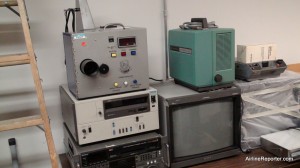
The Boeing Archives needs to keep a lot of classic viewing machines around.
What a job it would be to watch the videos to convert them over?! I did hint to Bernard what a GREAT TweetUp it would make to show a few of these old videos (Boeing 707 test videos anyone) to the general public. Not only does Boeing keep all the old formats, but they also must hold on to all sorts of format players. From 8-tracks to Laser discs, they have a vast collection of media players that could serve as its own mini-museum.
After checking out the videos, I got to check out the vault. Another locked room in a series of locked rooms. I would love to tell you what was in the vault but I can’t, but let me tell you, it was amazing.
Ok, I am joking, I can tell you what was in the vaultpretty much all the prized possessions of Boeing’s past. Some of the items include gifts given to them by world leaders and items gathered by previous Boeing leadership. Also found in the vault are the meeting minutes dictating all the decisions ever made by Boeing and very valuable Boeing memorabilia. It was at this point I made the joke about how much all this stuff would sell for on Ebay. Heh, Mike didn’t find it funny (ok maybe a little bit). Mike has a heart for all things that are Boeing and he hates seeing important trinkets being sold on Ebay for money. Many families of Boeing employees who pass away will happily donate their loved ones Boeing items to be preserved in history. Mike told me he often gets emails from people trying to sell Boeing items, thinking they have deep pockets, but Boeing is not in the business of buying memorabilia.
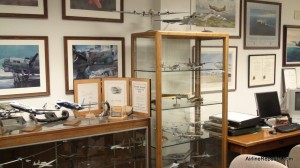
The Boeing Archive lobby had quite a few models, but that was nothing compared to what was inside the archives.
The archives are not just there to keep a hold of history. They are also there to help the future. Boeing engineers will often come to the archives so they don’t need to reinvent the wheel. If a Boeing engineer created a solution to a problem 30 years ago, current engineers can take a look at the old research and save time and money building off previous work.
So how does the general aviation nerd get access to the archives? Well the quick answer is that you can’t. They allow visits by non-Boeing guest on an extremely limited case-by-case basis. It is limited to academic researchers, the media, Boeing customers, museum staff, and established authors. However, enthusiasts can access Boeing archival information through the Boeing Images website. With Boeing making more of their archives digital and making more of an effort to connect with fans, we can hope that more of the fun stuff will be made public.
Even though I got to spend over an hour in the archives, I could have easily spent years without getting bored. Tomorrow, in Part 2, I will be posting about all the amazing models that are housed in the archives. In part 3, I will post an interview with Mike about his job and his thoughts on Boeing’s past, present and future. Stay tuned!
Inside The Boeing Company Archives
PART 1 | PART 2 | PART 3a | PART 3b | ALL PHOTOS | ALL STORIES
































